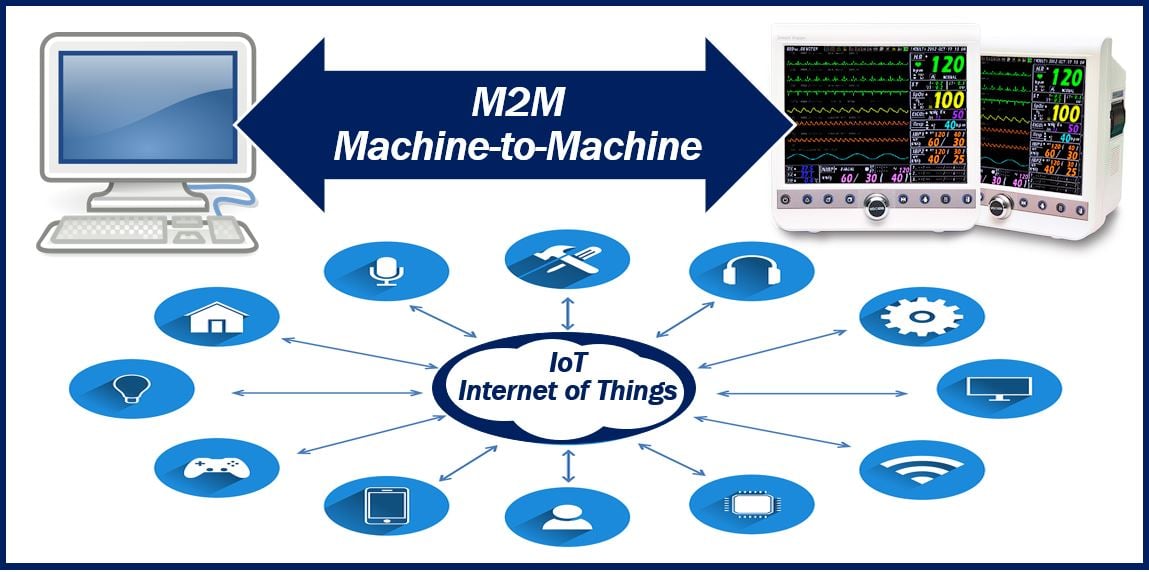Unlike what some would tell you, there is more to the difference between IoT and M2M than their name! Of course, both technologies have to do with connecting devices and transferring data without human input, but they don’t do so in exactly the same way, and therefore don’t cover the same range of applications.

Let us delve deeper into M2M and IoT solutions to see how they differ and why both are so important.
M2M Technology: The Original
Machine to Machine (M2M) is the term used to describe any form of machine to machine communication that doesn’t rely on human assistance. In the M2M paradigm, two or more machines are connected with one another according to a point to point architecture. What makes M2M communication unique is the proprietary protocols it usually utilizes. Because these systems are not Internet-bound (and that’s where IoT and M2M differ), they are not only more secure from a data protection perspective, but also extremely reliable, even in remote locations.
M2M solutions can make us of the GSM network, Bluetooth technology or even wired architectures which provide the system with exceptional reliability. The restricted scale of M2M implies that it is less suitable for the general public, but especially valuable for industrial applications.
M2M Applications
The characteristics of machine to machine communication make it especially relevant to B2B scenarios where autonomous decision-making processes and machine learning translate into more efficient or safer working environments.
For instance, oil-drilling equipment and infrastructure may be fitted with sensors to send pertinent, real time information to a hub which generates appropriate responses based on its interpretation of the data. Any issue is automatically reported, and security protocols are in effect without requiring validation from a human being.
Some B2C applications are also worth noting, such as smart metres which, while they are not exactly part of a smart home as such, automatizes the metre-reading process. While the energy or water provider has immediate access to the data and uses it to simplify billing or to generate extremely accurate statistics, they can exploit this data to offer their customers additional services.Using a smartphone app, they can keep track of their consumption in real time!
IoT: The Future of Connected Solutions
While M2M applications are plentiful, the technology isn’t extremely scalable. The Internet of Things (IoT) is derived from M2M in that it aims to create a network of connected devices that can theoretically be scaled up practically indefinitely. While various communication types are utilized, IP networks are the backbone of IoT (M2M, on the other hand, doesn’t typically rely on Internet protocols). The main difference between an M2M device and IoT devices is that IoT connected objects make use of Internet connectivity to exchange data with the immediate objective to address everyday needs humans may have.
IoT systems gather data from countless connected devices and makes it available to potentially anyone with access to the Internet. This B2C-oriented technology is one of the fastest growing assets of the 21st century and may already be encountered in a wide array of devices. IoT is well suited to grand-scale projects.
IoT Applications
As the Internet of Things relies on a wireless network many individuals have access to – the Internet – applications are quite numerous. Namely, this technology is behind what is broadly known as big data, or those pattern-revealing data sets that provide information on human-specific trends. Big data analytics has a wide range of applications from governmental processes to healthcare and, of course, the media industry.
Direct consumer applications of IoT include smart homes (where IoT and M2M sometimes overlap). Home automation, appliance monitoring, smart hubs are just a few of the many possibilities the Internet of Things brings into a 21st-century house.
Healthcare is another area where IoT truly shines, to the point that the term “Smart Healthcare” was even coined to refer to this new way of conceiving medicine. This is, in fact, a field where IoT and M2M offer complementary answers at this stage. For instance, smart beds are used in hospitals to alert medical personnel if a patient is attempting to get up or if an issue is detected. Meanwhile, IoT devices simplify medical follow-up by keeping reliable statistics on the evolution of a patient’s condition.
Umbrella solutions such as those offered by Matooma contribute to erasing the boundaries between IoT and M2M to bring ever more innovative uses of these technologies to businesses and individuals alike.
The foundations provided by M2M have also made it possible for IoT technologies to find applications in education,transportation, communication, manufacturing, agriculture, social engineering, energy management and more. As complex systems, IoT and M2M still haven’t revealed everything they have to offer, and humanity can expect to benefit from an even more connected world in the years to come.
Video – What is M2M (Machine-to-Machine)?
This interesting video presentation, from our sister channel in YouTube – Marketing Business Network, explains what a ‘Machine-to-Machine’ is using simple and easy-to-understand language and examples.
Interesting related article: “What is the Internet of Things?“

